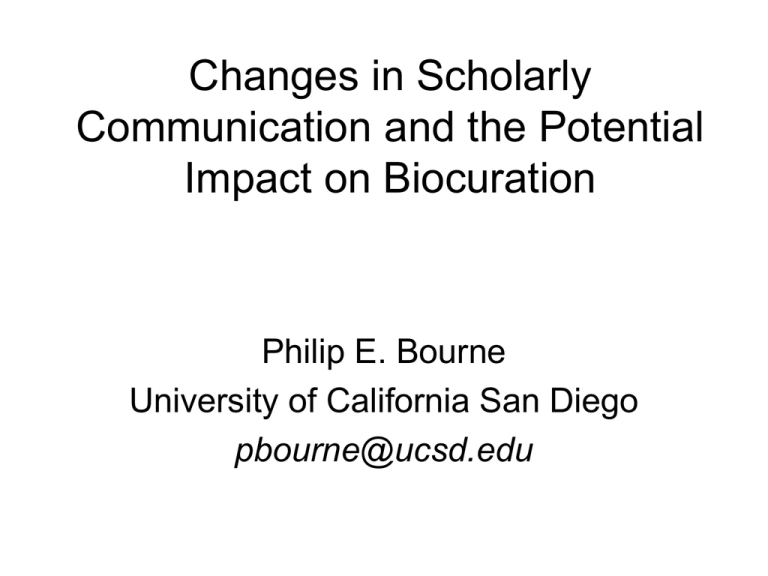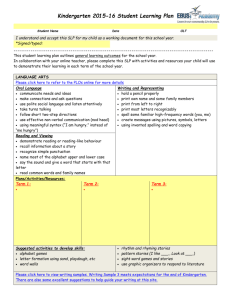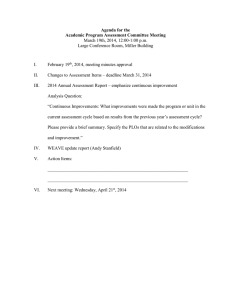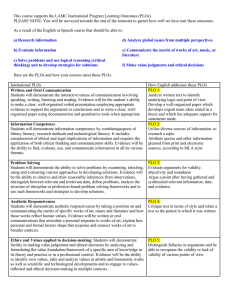Changes in Scholarly Communication and the Potential Impact on Biocuration Philip E. Bourne
advertisement

Changes in Scholarly Communication and the Potential Impact on Biocuration Philip E. Bourne University of California San Diego pbourne@ucsd.edu http://collections.plos.org/ploscompbiol/biocurators.php Some of What You Do – The Data Knowledge Cycle Mostly “Value Added Curation” The Cycle (You) Are Under Stress? • PubMed contains 18,792,257 entries • 50,000 papers indexed per month • In Feb 2009: – 67,406,898 interactive searches were done – 92,216,786 entries were viewed • 1078 databases reported in NAR 2008 • MetaBase http://biodatabase.org reports 2,651 entries edited 12,587 times Data as of April 14, 2009 The Cycle Some Comparisons • Journals have a pretty standardized interface • Journals have a business model • The quality is declining as numbers increase (?) • Audience believes they are sustainable • Efforts to make the interfaces different! • Little attempt at a business model compared to the Web 2.0 world • Not well sustained PLoS Comp. Biol. 2008. 4(7): e1000136 The Constituents are Changing • New publishing models eg open access, self publishing • Web 2.0 influence eg social networks • Use of rich media • The review process is failing • Read and write eg Wikis • New services eg restful Growth of PubMed Central Open Access (Creative Commons License) 1. All published materials available on-line free to all (author pays model) 2. Unrestricted access to all published material in various formats eg XML provided attribution is given to the original author(s) 3. Copyright remains with the author 12 July 2016 Open Access (Creative Commons License) 1. All published materials available on-line free to all (reader pays model) 2. Unrestricted access to all published material in various formats eg XML provided attribution is given to the original author(s) 3. Copyright remains with the author 12 July 2016 Open Access: Taking Full Advantage of the Content PLoS Comp. Biol. 2008 4(3) e1000037 So change is afoot… Hold that thought… At the same time think about the notion – is a biological database really that different from a biological journal? PLoS Comp. Biol. 2005 1(3) e34 Scholarly Communication Group • Can we improve the way science is disseminated and comprehended? • Through openness can we increase the number of people interested in science? The Test Bed http://www.plos.org/ http://www.pubmedcentral.nih.gov/ http://www.wwpdb.org/ 13 The World Wide Protein Data Bank http://www.wwpdb.org • The single worldwide repository for data on the structure of biological macromolecules • Vital for drug discovery and the life sciences • Over 30 years old • Free to all A Note in Passing • Structural biologists have been fervent about making the data associated with their studies freely available • For the most part they do not think the same way about the literature (knowledge) associated with the data – they hand it over without a second thought • This latter point is true of scientists in general The World Wide Protein Data Bank • Paper not published unless data are deposited – strong data to literature correspondence • Highly structured data conforming to an extensive ontology • DOI’s assigned to every structure http://www.wwpdb.org The PLoS Corpus • Established in 2000 • Identified as a high quality publications (PLoS Biology impact factor 14.7) • Currently 8 journals with healthy growth • Open Access – free to all The PLoS/PMC Corpus – Under the Hood • Conforms well/partially to the NLM DTD – little markup of content • PMC – some PDFs ! • The lack of conformance will come back to haunt us! Similar Processes Lead to Similar Resources Author Submission via the Web Syntax Checking Review by Scientists & Editors Corrections by Author Publish – Web Accessible Depositor Submission via the Web Syntax Checking Review by Annotators Corrections by Depositor Release – Web Accessible So the processes are not that dissimilar it is the final product that is perceived so differently Even that might be changing slowly? PLoS Comp. Biol. 2008 4(12) e1000247 We are seeing a gray area emerging between what was traditionally literature and what was traditionally databases Examples of the Gray Area • More data and rich media are being provided as supplemental information • Software deposition is being encouraged • All that you do in adding literature annotations to databases Facilitators of Change (and very useful tools for you) Embedding semantic data during manuscript authoring Creates an improved interface between databases and the literature Lynn Fink jlfink@ucsd.edu http://biolit.ucsd.edu Get the authors involved • Authors are the absolute experts on the content • More effective distribution of labor • Add metadata before the article enters the publishing process Word 2007 Add-in for authors • Allows authors to add metadata as they write, before they submit the manuscript • Authors are assisted by automated term recognition – OBO ontologies – Database IDs • Metadata are embedded directly into the manuscript document via XML tags, OOXML format – Open – Machine-readable • Open source, Microsoft Public License http://www.codeplex.com/ucsdbiolit Add-in Capabilities • Inline Recognition, Highlighting, and Mark-up of Informative Terms – A recognized term will have a dotted, purple underline – Hovering generates a Smart Tag above the term • • • • add mark-up for this term ignore this term view the term in the ontology browser If a recognized term appears in more than one ontology, all instances of that term will be listed – Hovering over a marked-up term • option to apply mark-up to all recognized instances of term • stop recognizing a term • Built-in Knowledge of Ontologies and Databases – Add-in provides a list of biomedical ontologies to download – and a list of databases for ID recognition (GenBank/RefSeq, UniProt, Protein Data Bank) – A user may also supply a URL to download other ontologies (soon) • Ontology Browser – allows a user to select an ontology and then navigate through it to view terms and their relationships Custom Metadata • Ontologies do not contain all usages of a concept • Add-in allows user to assign custom metadata • Human Disease Ontology term: Leukemia, T-Cell, HTLV-II-Associated • Synonym: Atypical hairy cell leukemia (disorder) • Actual use in literature: – – – – hairy cell leukemia hairy-cell leukemia hairy T cell leukemia T cell hairy leukemia Synonym mapping, disambiguation • Inclusion of an additional set of synonyms for a term that reflect its use in natural language – Automated finding of synonyms in extant literature – Gather synonyms from term-mapping databases • Incorporate a more sophisticated term recognition approach into the add-in Challenges • Author use – Familiarity with ontologies, terms – Agreement between co-authors • End-use of semantically enriched manuscript – Combine with NLM XML standard • Article Authoring Add-in Author Use IF one or more publishers fast tracked a paper that had semantic markup I would argue it would catch on in no time BioLit, post-processed automated With such semantic tagging of the literature consider how it might be integrated with databases and vice-versa First let us consider where we stand today Data Database Knowledge Knowledgebase Data Only Wikis Datapacks Journals Annotation Data + Annotation Data + Some Annotation Data + Some Annotation + Some Integration The Data – Knowledge Spectrum BioLit: Tools for New Modes of Scientific Dissemination The Knowledge and Data Cycle 0. Full text of PLoS papers stored in a database 4. The composite view has links to pertinent blocks of literature text and back to the PDB 4. 1. 1. A link brings up figures from the paper 3. A composite view of journal and database content results 3. 2. 2. Clicking the paper figure retrieves data from the PDB which is analyzed • Biolit integrates biological literature and biological databases and includes: – A database of journal text – Authoring tools to facilitate database storage of journal text – Tools to make static tables and figures interactive http://biolit.ucsd.edu 36 http://biolit.ucsd.edu Nucleic Acids Research 2008 36(S2) W385-389 PSP Washington DC Feb. 2008 37 38 39 ICTP Trieste, December 10, 2007 41 Data Clustering via the Literature Cardiac Disease Literature Immunology Literature We can take this integration of literature and database content a step further… Enter PLoS iStructure An interactive journal Data Database Knowledge Knowledgebase Data Only Wikis Datapacks Journals Annotation Data + Annotation Data + Some Annotation Data + Some Annotation + Some Integration The Data – Knowledge Spectrum PLoS iStructure Enter PLoS iStructure … • Authoring starts with a PDB file • Annotated molecular views are added – the associated metadata defining those views is stored with the publication • Other data types can be validated and added through semantic association • Rich media can be added through embedding • The resultant publication is peer reviewed and may be published Enter PLoS iStructure • The “reader” has new opportunities for comprehension and analysis • The journal is an interface to to apply the knowledge found in the paper immediately and seamlessly eg each table is a spreadsheet • Comparative analysis can be performed directly from the paper Even a more interactive journal can benefit from rich media types Video can bring so much to the learning experience Notion of traditional publications being associated with podcasts and video www.scivee.tv Pubcast – Video Integrated with the Full Text of the Paper The opposite view is to embed a SciVee video in a published paper Provides multiple entry points to that paper and may impact downloads and perhaps citations In Five Years if There Were More Journals Like iStructure How Would it Impact Curation? • Certainly it would change the way curation is done. However… • There is no escapaing the value that a human as a third party can add value to the final product – the product is different is all Acknowledgements • BioLit Team – – – – – Lynn Fink Parker Williams Marco Martinez Rahul Chandran Greg Quinn • Microsoft Scholarly Communications – – – – – Pablo Fernicola Lee Dirks Savas Parastitidas Alex Wade Tony Hey http://biolit.ucsd.edu http://www.codeplex.com/ucsdbiolit • wwPDB team • SciVee Team – Apryl Bailey http://www.scivee.tv – Tim Beck – – – – – – Leo Chalupa Lynn Fink Marc Friedman (CEO) Ken Liu Alex Ramos Willy Suwanto pbourne@ucsd.edu Questions? Additional Reading:



